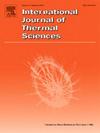新型折流板管式换热器的强化传热:数值研究与实验验证
IF 4.9
2区 工程技术
Q1 ENGINEERING, MECHANICAL
International Journal of Thermal Sciences
Pub Date : 2025-04-20
DOI:10.1016/j.ijthermalsci.2025.109936
引用次数: 0
摘要
受萨沃尼乌斯涡轮机湍流结构的启发,我们开发了一种名为 SSB(萨沃尼乌斯形挡板)的创新挡板,用于增强管式热交换器(THX)中的对流换热。通过 280 次计算流体动力学(CFD)模拟,对挡板的几何参数进行了广泛评估,包括旋转角度(-45°≤α ≤45°)、间距比(0.625≤PR ≤2.5)和长宽比(0.5≤AR≤1),以评估不同雷诺数(5000≤Re ≤25000)下的努塞尔特数(Nu)、摩擦因数(f)和热增强因数(TEF)。稳态流动条件下的空气被视为工作流体,流经 THX 的光滑壁面。使用 K-ε-Realizable 模型对流动的湍流行为进行了预测。制造的实验装置和经验相关性都验证了结果。研究发现,由于湍流产生的性质,在 Re = 15000/PR = 0.625/α = 0° 的条件下,与普通管道相比,SSB 可以将 Nu 提高约 345%。研究还表明,Nu 和 f 随 AR 和 Re 的增加而增加,而 PR 则随 AR 和 Re 的减小而减小,TEF 则随 AR 和 Re 的减小而减小。当 AR = 0.5/Re = 5000/PR = 1.75/α = - 45° 时,达到的最大 TEF 为 1.35。最后,假设条件平稳,考虑到普朗特数 (Pr)、开口率 (OR)、Re 和 PR,建立了一个经验相关性来预测 Nu,AR = 1 和 AR = 0.5 时的绝对平均相对偏差 (AARD%) 分别约为 9.64 % 和 4.32 %。本文章由计算机程序翻译,如有差异,请以英文原文为准。

Heat transfer enhancement in a tubular heat exchanger fitted with a novel baffle: A numerical study and experimental validation
Inspired by the turbulence structure in Savonius turbines, an innovative baffle called SSB (Savonius-shaped baffle) was developed to enhance the convective heat transfer in a tubular heat exchanger (THX). The geometrical parameters of the baffles, including rotational angle(-45°≤α ≤ 45°), pitch ratio (0.625≤PR ≤ 2.5), and aspect ratio (0.5≤AR≤1), have been extensively evaluated through 280 Computational Fluid Dynamics (CFD) simulations to assess the Nusselt number (Nu), friction factor (f), and thermal enhancement factor (TEF) at various Reynolds numbers (5000≤Re ≤ 25000). Air, under steady-state flow conditions, was considered the working fluid, flowing through the smooth wall of the THX. The turbulence behavior of the flow was predicted using the K-ε-Realizable model. Both the fabricated experimental setup and empirical correlations validated the results. It was found that, due to the nature of turbulence generation, the SSB can enhance Nu by approximately 345 % at Re = 15000/PR = 0.625/α = 0° compared to plain tubes. It also revealed that Nu and f increase as AR and Re increase, while PR decreases and TEF decreases as AR and Re decrease. The maximum TEF achieved was 1.35 at AR = 0.5/Re = 5000/PR = 1.75/α = - 45°. Finally, assuming smooth conditions, an empirical correlation has been developed to predict Nu, taking into account Prandtl number (Pr), opening ratio (OR), Re, and PR, with absolute average relative deviations (AARD%) approximately equal to 9.64 % and 4.32 % for AR = 1 and AR = 0.5, respectively.
求助全文
通过发布文献求助,成功后即可免费获取论文全文。
去求助
来源期刊

International Journal of Thermal Sciences
工程技术-工程:机械
CiteScore
8.10
自引率
11.10%
发文量
531
审稿时长
55 days
期刊介绍:
The International Journal of Thermal Sciences is a journal devoted to the publication of fundamental studies on the physics of transfer processes in general, with an emphasis on thermal aspects and also applied research on various processes, energy systems and the environment. Articles are published in English and French, and are subject to peer review.
The fundamental subjects considered within the scope of the journal are:
* Heat and relevant mass transfer at all scales (nano, micro and macro) and in all types of material (heterogeneous, composites, biological,...) and fluid flow
* Forced, natural or mixed convection in reactive or non-reactive media
* Single or multi–phase fluid flow with or without phase change
* Near–and far–field radiative heat transfer
* Combined modes of heat transfer in complex systems (for example, plasmas, biological, geological,...)
* Multiscale modelling
The applied research topics include:
* Heat exchangers, heat pipes, cooling processes
* Transport phenomena taking place in industrial processes (chemical, food and agricultural, metallurgical, space and aeronautical, automobile industries)
* Nano–and micro–technology for energy, space, biosystems and devices
* Heat transport analysis in advanced systems
* Impact of energy–related processes on environment, and emerging energy systems
The study of thermophysical properties of materials and fluids, thermal measurement techniques, inverse methods, and the developments of experimental methods are within the scope of the International Journal of Thermal Sciences which also covers the modelling, and numerical methods applied to thermal transfer.
 求助内容:
求助内容: 应助结果提醒方式:
应助结果提醒方式:


